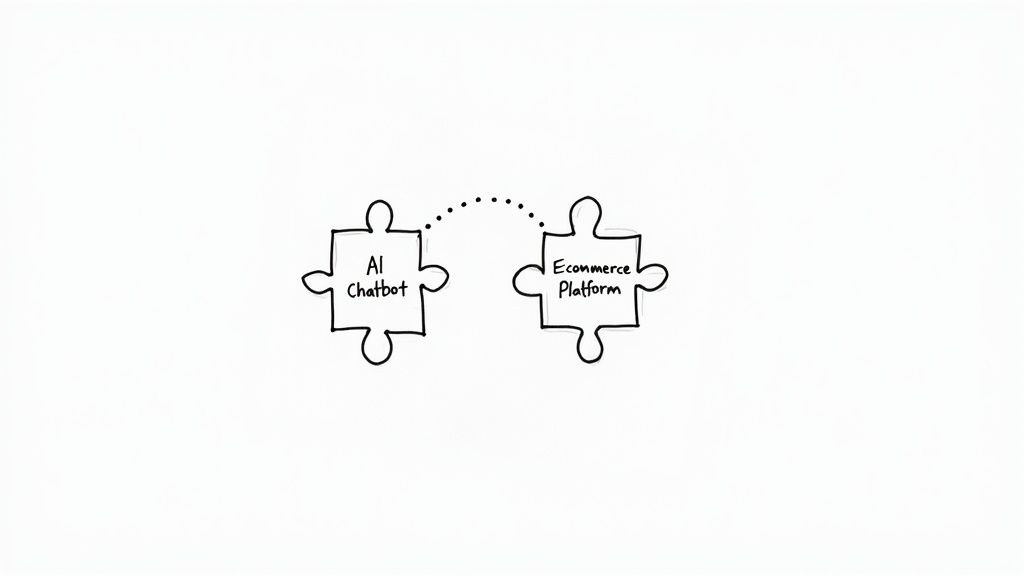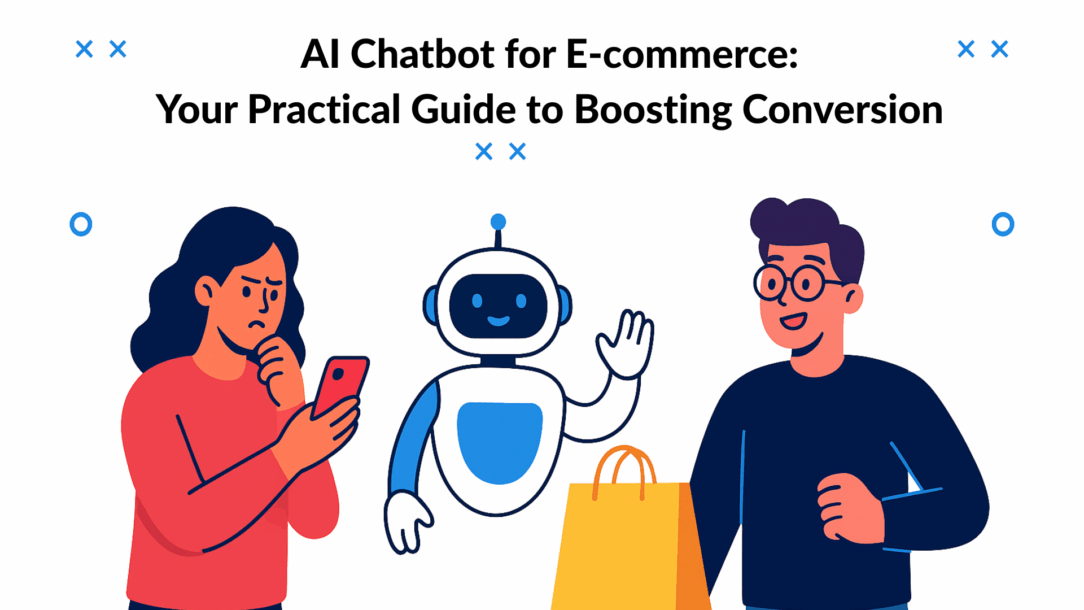An AI chatbot for e-commerce is your best salesperson, working 24/7. It’s an automated tool that actively engages visitors, answers questions instantly, and guides them toward a purchase. Think of it as a dedicated expert for every single shopper, turning passive browsing into a helpful, one-on-one conversation.
This guide gives you actionable insights and practical examples to show you how this technology transforms online stores and drives real results.
Your 24/7 Sales Assistant Is Here
Imagine cloning your top employee and having them greet every customer the moment they land on your site. That’s the reality of a modern AI chatbot. Old chatbots were clunky and frustrating, stuck on rigid scripts. Today’s AI-powered versions are completely different.
They use advanced technology to understand what customers are asking for—typos, slang, and all—and provide genuinely helpful answers. This changes the shopping experience from a lonely, self-guided chore into a dynamic and supportive journey.
Solving Key E-commerce Challenges
Every online store faces the same tough challenges: high cart abandonment, slow customer service, and a one-size-fits-all experience that fails to connect with shoppers. An AI chatbot tackles these problems head-on.
Instead of waiting hours for an email response, customers get instant answers about shipping, returns, or product details. That speed is crucial. A staggering 53% of online shoppers will abandon their cart if they can’t find a quick answer.
An AI chatbot acts as a proactive guide, preventing the frustration that leads to lost sales. For merchants, understanding how AI shopping agents for Shopify work is a great starting point to see these tools in action as tireless assistants.
Actionable Takeaway: By engaging shoppers at critical moments—like when they hesitate on a product page or right before checkout—an AI assistant can clear up confusion, offer a timely discount, or suggest a better alternative. That’s how you save a sale in real-time.
More Than Just Customer Service
While handling support tickets is a huge benefit, the real power of an AI chatbot for e-commerce is its ability to actively drive revenue. It’s not just a defensive tool for putting out fires; it’s a key player in your sales strategy.
Here’s what that looks like in practice:
- Personalized Recommendations: A shopper asks, “Do you have any waterproof jackets under $150?” The bot instantly filters your catalog and presents the top three options, complete with customer ratings.
- Proactive Engagement: A chatbot can welcome new visitors with a 10% discount code, announce a flash sale, or pop up with an offer to help if someone seems stuck on a page for too long.
- Lead Qualification: For high-value items, the bot can ask smart questions to understand a shopper’s needs and budget, qualifying them as a hot lead before handing them off to a human agent to close the deal.
This transforms every interaction into an opportunity to build a relationship and increase your average order value.
How AI Chatbots Redefine Online Shopping
An AI chatbot does more than just answer questions; it fundamentally changes the feel of your online store. It elevates the experience from a static product catalog to an interactive, guided journey. In short, it gives every visitor their own personal shopper.
This isn’t just about convenience. It’s about making the entire shopping process smarter, faster, and more personal, which leads directly to better business results.
From Passive Browsing to Active Selling
Traditional e-commerce forces customers to do all the work—navigating menus, using search filters, and comparing products alone. An AI chatbot for e-commerce flips that script by actively participating in the discovery process.
Practical Example: Someone lands on a page with hundreds of running shoes. The chatbot can ask, “Welcome! Are you looking for shoes for trail running, road racing, or daily training?” That simple question instantly cuts through the clutter, prevents overwhelm, and directs the customer straight to what they need.
This proactive assistance ensures customers find the right product, which naturally boosts the likelihood of a sale.
24/7 Support That Frees Up Your Team
One of the biggest wins is offering instant, around-the-clock support. Shoppers don’t stick to business hours. A chatbot can handle a massive volume of common questions simultaneously, without any delay.
- Order Status: Instantly answers “Where’s my order?” by integrating with your store’s backend.
- Return Policies: Clearly explains your return process, eligibility, and next steps.
- Product Specs: Provides details like dimensions, materials, or compatibility on demand.
This automation frees your human support team from repetitive tasks. Instead of resetting passwords, they can focus on complex issues that require a human touch, like handling a shipping issue or advising on a large purchase.
Real-World Result: By automating up to 80% of routine questions, an AI chatbot gives your team the breathing room to deliver exceptional service where it matters most, improving both employee and customer satisfaction.
A Powerful Tool for Business Intelligence
Every conversation a chatbot has is a goldmine of customer data. These chats capture the raw, unfiltered voice of your audience—what they’re asking for, what frustrates them, and what they wish you offered.
This feedback loop is incredibly powerful for making data-driven decisions.
Practical Example: If multiple customers ask whether a specific jacket is waterproof, that’s a clear signal to update your product description. If shoppers keep asking for a product you don’t stock, you’ve just identified a potential new bestseller.
This insight helps you fine-tune marketing, improve products, and enhance the entire customer experience. For a deeper dive, check out these insights on how Artificial Intelligence impacts B2C marketing.
The E-commerce Shift with AI Chatbots
Let’s break down the transformation with a simple before-and-after comparison.
| Business Challenge | Traditional E-commerce Approach | AI Chatbot Solution |
|---|---|---|
| High Cart Abandonment | Sending a follow-up email 24 hours later, hoping the customer returns. | Proactively engaging the user with a targeted discount or offer before they leave the site. |
| Slow Support Responses | A ticket system with an average response time of several hours or even days. | Instant, 24/7 answers to common questions, resolving issues in real time. |
| Generic User Experience | Displaying the same best-sellers and promotions to every single visitor. | Offering personalized product recommendations based on browsing behavior and direct queries. |
As you can see, it’s not just about doing the same things faster. It’s about fundamentally changing the interaction from reactive to proactive, which makes all the difference.
Must-Have Features in a Winning Chatbot
Not all chatbots are created equal. A basic scripted pop-up is a world away from a true AI chatbot for e-commerce designed to drive sales and support. To get real results, your tool needs a specific set of features that turn simple chats into profitable conversations.
The difference comes down to intelligence and integration. A winning chatbot understands context, adapts to the user, and connects seamlessly with the tools you already use.
Natural Language Processing (NLP)
This is the single most important feature. NLP is the technology that lets the bot understand how real people talk—including typos, slang, and incomplete sentences. Without strong NLP, a chatbot is just a frustrating, glorified FAQ page.
Practical Example: A customer types, “Hey, do u have this tee in blue L?” A basic bot would fail. A bot with NLP understands the user wants a large, blue T-shirt and can instantly check your inventory or direct them to the correct product page. This human-like understanding is essential for a positive experience.

AI chatbot to ecommerce platform
This screenshot highlights how an integrated chat tool gives your team immediate access to customer details, order history, and product information within the conversation, enabling fast, personalized support.
Seamless Platform Integration
Your chatbot cannot operate in a vacuum. It must connect deeply with your e-commerce platform, whether that’s Shopify, BigCommerce, or WooCommerce. This integration is what allows the bot to perform meaningful, revenue-generating actions.
Actionable Takeaway: A chatbot that can’t access your product catalog or check order statuses is just a contact form. Its real power comes from tapping into live store data to provide instant, accurate answers.
Key integrations you need:
- Product Catalog Sync: Allows the bot to recommend products, check stock levels, and answer specific item questions.
- Order Management System: Empowers the bot to provide shipping updates, handle return requests, and look up order histories.
- Customer Relationship Management (CRM): It lets the bot recognize returning customers and deliver a truly personal experience. Our guide explores how to use this data to build stronger relationships.
Proactive Messaging and Engagement
The best chatbots don’t just wait for a customer to start a chat. They use proactive messaging to engage visitors at the perfect moment based on specific triggers—like time on page, items viewed, or exit intent.
Practical Example: If a shopper has been comparing two different products for over a minute, the bot can offer a side-by-side comparison. If someone is about to abandon a full cart, the bot can swoop in with a limited-time free shipping code to rescue the sale. This turns your bot from a passive tool into an active sales driver.
Intelligent Human Handover
Even the smartest AI has limits. For complex or sensitive issues, nothing beats a real person. That’s why an intelligent escalation path, or human handover, is a must-have feature. It ensures a smooth transfer to a live agent when needed.
The process should be seamless. The bot gathers initial information, then provides the human agent with the full chat history so the customer never has to repeat themselves. This hybrid approach delivers the best of both worlds: instant AI support and expert human help.
See How Top Brands Use AI Chatbots

chatbots for top brands
Theory is one thing, but seeing an AI chatbot for e-commerce in action reveals its true power. The smartest brands use these tools as strategic assets to solve real business problems, drive sales, and build lasting customer relationships.
Let’s look at some real-world use cases that show how a well-implemented chatbot becomes an essential part of the modern e-commerce playbook.
The Virtual Stylist Revolutionizing Fashion Retail
The Problem: A major online fashion retailer faced “analysis paralysis.” With thousands of items, shoppers were overwhelmed, leading to high bounce rates and low order values. They needed to replicate the personal touch of an in-store stylist online.
The Solution: They launched an AI chatbot as a “Virtual Stylist.” The bot proactively engages visitors with style quizzes, asking about their tastes, the occasion, and their budget. Based on the answers, it curates entire outfits—recommending a dress, then suggesting the perfect shoes and handbag to match.
The Results:
- Average Order Value (AOV) jumped by 22% as customers purchased complete looks.
- Conversion rates for shoppers using the bot were 3x higher than for those who didn’t.
- Time spent on the site doubled, keeping buyers engaged.
The Product Matchmaker for Beauty Brands
The Problem: A popular beauty brand was losing money on product returns because customers were buying the wrong shade of foundation or the wrong product for their skin type.
The Solution: They deployed an AI chatbot as a “Beauty Advisor.” The bot guides customers through a quick diagnostic chat, asking key questions about their skin concerns, tone, and desired finish. It then delivers a highly accurate product recommendation, complete with user reviews and application tips, removing the guesswork.
The Impact: The brand saw a 35% drop in product returns within six months, and customer satisfaction scores soared because people felt confident in their purchases.
Boosting Sales with Proactive Cart Recovery
The Problem: A home goods store was bleeding revenue from abandoned carts. Follow-up emails were often too late or ignored. They needed a real-time solution.
The Solution: They used their AI chatbot to trigger a proactive message the moment a user showed “exit intent” on the checkout page. If a shopper’s mouse moved toward the close button, the bot would pop up with a helpful message, like an offer to answer questions or a limited-time free shipping code.
The Result: The store recovered 15% more abandoned carts in the first quarter, directly translating to a significant lift in revenue.
You can explore a variety of tools that offer this functionality in this guide to the 5 best chatbots for ecommerce in 2024.
Deploying Your First E-commerce Chatbot
Getting started with an AI chatbot is more straightforward than you might think. Here’s a simple, four-stage roadmap to take you from idea to a live, value-adding bot.
Think of it like hiring a new team member. You need to define their role, train them on your products, and set clear goals. Applying the same logic here will set your AI chatbot for e-commerce up for success from day one.
Stage 1: Start with Clear Goals
Before looking at any platforms, answer one question: What problem am I trying to solve? A chatbot without a clear purpose is just a gimmick. Your goals must be specific, measurable, and tied to business results.
Instead of a vague goal like “better support,” get granular.
- Reduce Support Tickets: Aim to cut inbound questions by 30% by automating answers to your top five FAQs.
- Increase Conversion Rate: Set a goal to lift conversions by 5% for visitors who interact with the bot.
- Boost Average Order Value: Target a 10% increase in AOV by programming the bot to suggest relevant upsells.
- Improve Lead Generation: Capture 20% more qualified leads by using the bot to engage visitors and collect contact info.
With clear metrics, your chatbot becomes a measurable growth engine with a provable ROI.
Stage 2: Choose the Right Platform
Now that you have goals, you can find a platform with the right tools. The best choice depends on your specific needs, technical comfort level, and budget.
Most e-commerce brands should look for a platform with a user-friendly, no-code builder. This lets you design conversations with simple drag-and-drop interfaces, no developer required. Our complete guide on how to make an AI chatbot walks through both the tech and strategy.
Actionable Takeaway: Prioritize seamless integration. Your chatbot must connect easily with your e-commerce platform (like Shopify or WooCommerce), CRM, and email marketing tools. A connected bot is an effective bot.
Stage 3: Design and Train Your Bot
This is where you bring your chatbot’s personality and purpose to life. Start by mapping out the most common customer journeys and creating conversation flows that feel natural and helpful.
Focus your initial training on two key areas:
- Frequently Asked Questions (FAQs): Build a knowledge base with clear answers to common questions about shipping, returns, and sizing. This is the foundation of its support function.
- Product Catalog: Sync your entire product catalog so the bot can answer detailed questions, check inventory, and make relevant recommendations.
Don’t forget to define your bot’s voice. Is it friendly and casual? Professional and direct? Ensure its tone aligns with your brand’s personality in every interaction.
Stage 4: Test and Launch in Phases
Never launch your chatbot to all visitors at once. A phased rollout is crucial for catching bugs and refining conversations before they impact your brand.
Start by testing the bot internally with your team. Encourage them to try and “break” it with unusual questions.
Next, launch it to a small segment of your website traffic—perhaps 5-10% of visitors. Monitor the analytics closely. Are customers finding what they need? Where are conversations dropping off? Use this real-world data to make improvements.
This cycle of testing, learning, and refining is what separates a great chatbot from a mediocre one. Once it’s hitting your performance goals with the test group, you can confidently roll it out to everyone.
Common Questions About E-commerce Chatbots

common questions about e-commerce chatbots
It’s smart to have questions before adding an AI chatbot for e-commerce to your store. Let’s tackle the most common concerns about cost, team impact, and real-world results head-on.
How Much Does an E-commerce AI Chatbot Cost?
The cost varies widely, which means there’s a solution for almost any budget. Think of it like a subscription service.
- Entry-Level: Simple, template-based bots can cost as little as $20 to $50 per month, perfect for handling basic FAQs and capturing leads.
- Mid-Tier: More advanced bots with custom AI and deeper integrations typically range from a few hundred to several thousand dollars per month.
- Enterprise: Large-scale, fully custom builds can have initial setup costs from $5,000 to over $50,000.
The key is to find a pricing model—whether per conversation, per user, or a flat fee—that aligns with your traffic and business goals.
Will an AI Chatbot Replace My Customer Service Team?
No, it will empower them. An AI chatbot is a force multiplier that makes your human team more effective, not obsolete. It handles the repetitive, high-volume questions that burn out your agents.
The bot excels at instantly answering “Where is my order?” or “What’s your return policy?” 24/7. This frees up your human team to focus on complex, high-value, or sensitive issues that require empathy and critical thinking.
The Best Practice: Use a hybrid model. The AI handles the first line of defense, with a seamless “human handover” feature to pass complex conversations to a live agent. You get the efficiency of AI and the expertise of your team.
How Do I Measure the ROI of a Chatbot?
Measuring the return on your investment is straightforward if you track the right metrics across sales, operations, and customer satisfaction.
Here’s what to track:
- Sales and Revenue: Monitor the conversion rate of shoppers who engage with the bot. Track sales generated directly from bot recommendations, upsells, or cart recovery actions.
- Operational Savings: Count the number of support tickets the bot deflects. Calculate the cost savings based on your average cost-per-ticket.
- Customer Satisfaction: Measure post-chat CSAT (Customer Satisfaction) scores and look for improvements in average response times and a decrease in negative feedback.
Tracking these numbers will clearly demonstrate the financial and experiential value your AI chatbot for e-commerce is delivering.
Can a Chatbot Integrate with My Existing Tools?
Yes, and this is non-negotiable. A chatbot that can’t communicate with your other tools is just a website widget. Its real power comes from strong integrations.
The best platforms for ecommerce have pre-built connectors for major e-commerce systems for real-time access to product and order data.
Beyond your storefront, ensure it integrates with:
- CRM Software: Connecting to platforms like HubSpot syncs customer data for a unified view of every interaction.
- Help Desk Software: Integrating with tools like Zendesk ensures that human handovers are logged as support tickets automatically.
This creates a connected tech stack where information flows freely, breaking down data silos and enabling a truly seamless and personalized customer journey.
AI Chatbot for E-Commerce
In the rapidly evolving world of online retail, AI chatbots for e-commerce have become essential tools for ecommerce businesses. These AI-powered chatbots can provide a range of services, enhancing customer experience and streamlining operations.
What is an E-Commerce Chatbot?
An ecommerce chatbot is a computer program designed to simulate conversation with users. It can engage customers through various messaging platforms, providing immediate assistance and information.
How Does an AI Chatbot Help E-Commerce?
Chatbots can engage customers by answering queries, providing product recommendations, and assisting with the checkout process. This level of support is crucial for online retailers looking to improve customer satisfaction and increase sales.
Benefits of Using a Chatbot for E-Commerce
- 24/7 Availability: Chatbots can operate around the clock, ensuring that customers receive help whenever they need it.
- Cost-Effective: Utilizing an AI platform for customer service reduces the need for a large support team.
- Personalized Shopping Assistant: An AI chat can remember customer preferences and tailor recommendations accordingly.
- GDPR-Compliant: Many chatbots are designed to be compliant with data protection regulations, ensuring customer data is handled safely.
Choosing the Best AI for Your Shopify Store
When selecting a chatbot for ecommerce, consider features such as integration with your Shopify store, user-friendliness, and the availability of a free plan to test the service. Leading ecommerce chatbots provide advanced features that can cater to various business needs.
Conclusion
Incorporating an ecommerce chatbot into your online store can significantly enhance customer engagement and streamline operations. By leveraging AI tools, you can ensure that your business stays competitive in the digital marketplace.
In today’s competitive landscape, leveraging an AI agent for e-commerce can significantly enhance customer engagement and streamline customer support. By utilizing advanced AI technology, e-commerce sites can create a chatbot that engages with website visitors, manages customer inquiries, and provides personalized shopping experiences. The best ecommerce chatbots seamlessly integrate with platforms like Shopify, allowing you to improve customer interactions and support whenever needed.
Investing in a conversational AI chatbot platform like Clepher not only enables you to train your chatbot effectively but also empowers it to handle customer queries across multiple channels, including Facebook Messenger. With Clepher’s lifetime deal, you can explore the capabilities of an AI-powered chatbot and see how it can transform your e-commerce store into a hub of conversational commerce.
Don’t miss out on the opportunity to enhance your overall customer experience. Start your journey with Clepher today and create a chatbot that will revolutionize your e-commerce site. Embrace the future of shopping with the best AI-powered ecommerce solutions!
Get started with Clepher now and elevate your e-commerce business!
Related Posts



